Intro
When I first built my Proxmox VE 8 cluster, networking wasn’t my main concern. I just wanted to replace an old physical server quickly, so I gave each of my three nodes the same basic config, created the cluster, and started running VMs:

That worked fine for a while. But as I plan to virtualize my OPNsense router, I need something more structured and consistent. This is where Proxmox Software-Defined Networking (SDN) feature comes in.
My Homelab Network
By default, every Proxmox node comes with its own local zone, called localnetwork, which contains the default Linux bridge (vmbr0) as a VNet:
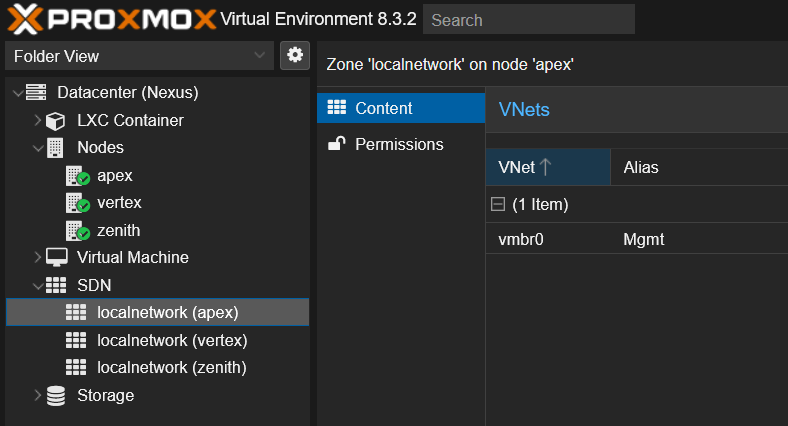
That’s fine for isolated setups, but at the cluster level nothing is coordinated.
What I want is simple: declare the VLANs I already use in my network, so I can attach VMs to them easily from any node.
Here’s the list of VLANs I use today:
| Name | ID | Purpose |
|---|---|---|
| Mgmt | 1 | Management |
| User | 13 | Home network |
| IoT | 37 | IoT and untrusted equipments |
| DMZ | 55 | Internet facing |
| Lab | 66 | Lab network |
| Heartbeat | 77 | Proxmox cluster heartbeat |
| Ceph | 99 | Ceph storage |
| VPN | 1337 | Wireguard network |
Proxmox SDN Overview
Proxmox Software-Defined Networking makes it possible to define cluster-wide virtual zones and networks. Instead of repeating VLAN configs on every node, SDN gives you a central view and ensures consistency.
Under the hood, Proxmox mostly uses standard Linux networking, avoiding extra dependencies and keeping things stable.
SDN configurations are stored in /etc/pve/sdn, which is replicated across the cluster. Changes are applied atomically (you prepare them, then hit Apply once), making rollouts safer.
Zones
A Zone defines a separate networking domain. Zones can span specific nodes and contain VNets.
Proxmox supports several zone types:
- Simple: Isolated Bridge. A simple layer 3 routing bridge (NAT)
- VLAN: Virtual LANs are the classic method of subdividing a LAN
- QinQ: Stacked VLAN (IEEE 802.1ad)
- VXLAN: Layer 2 VXLAN network via a UDP tunnel
- EVPN: VXLAN with BGP to establish Layer 3 routing
Since my home network already relies on VLANs, I created a VLAN Zone named homelan, using vmbr0 as the bridge and applying it cluster-wide:
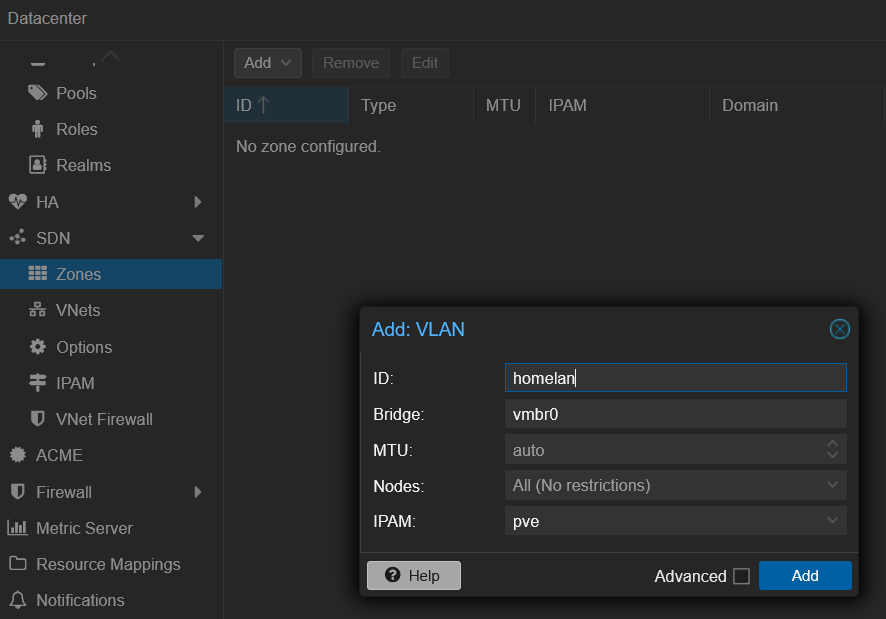
VNets
A VNet is a virtual network inside a zone. In a VLAN zone, each VNet corresponds to a specific VLAN ID.
I started by creating vlan55 in the homelan zone for my DMZ network:
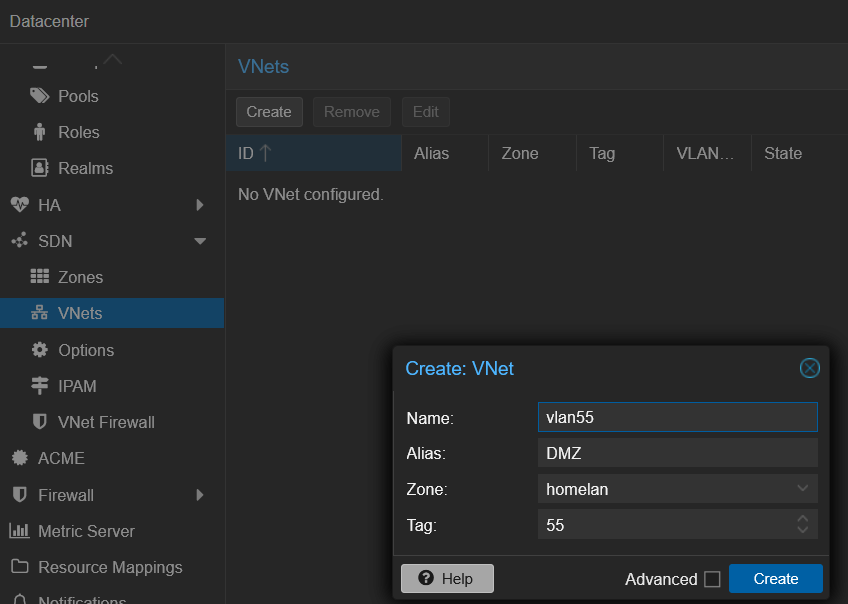
Then I added VNets for most of my VLANs, since I plan to attach them to an OPNsense VM:
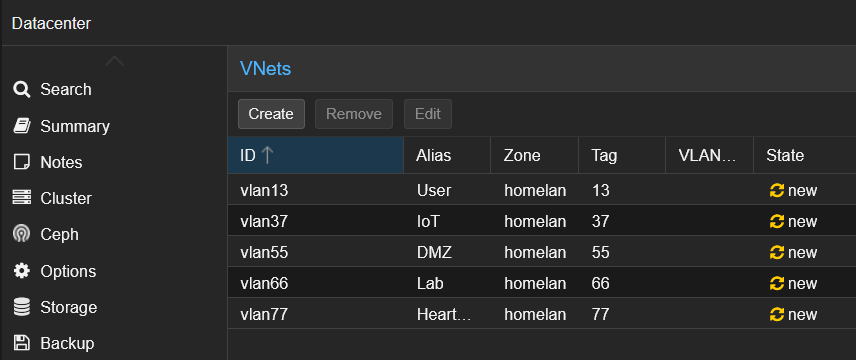
Finally, I applied the configuration in Datacenter → SDN:
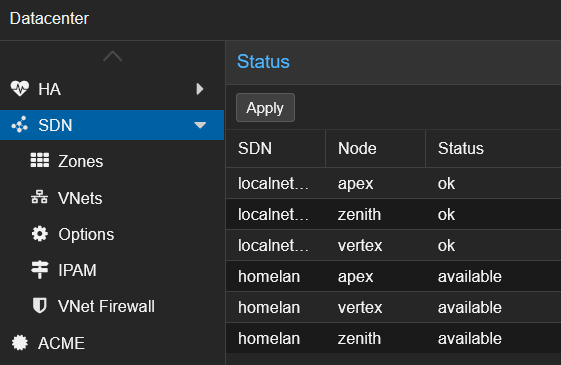
Test the Network Configuration
In a old VM which I don’t use anymore, I replace the current vmbr0 with VLAN tag 66 to my new VNet vlan66:
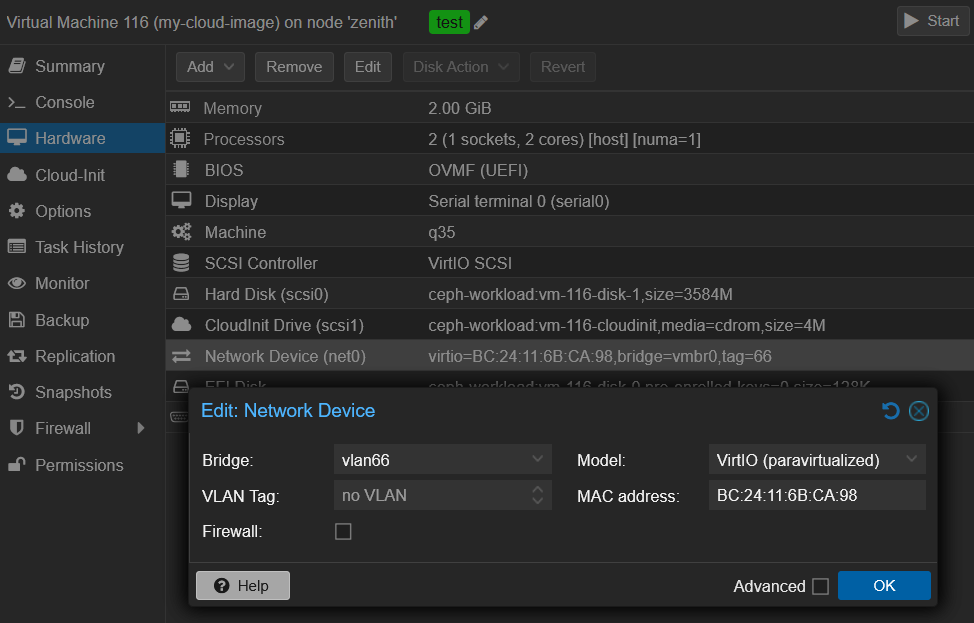
After starting it, the VM gets an IP from the DHCP on OPNsense on that VLAN, which sounds good. I also try to ping another machine and it works:
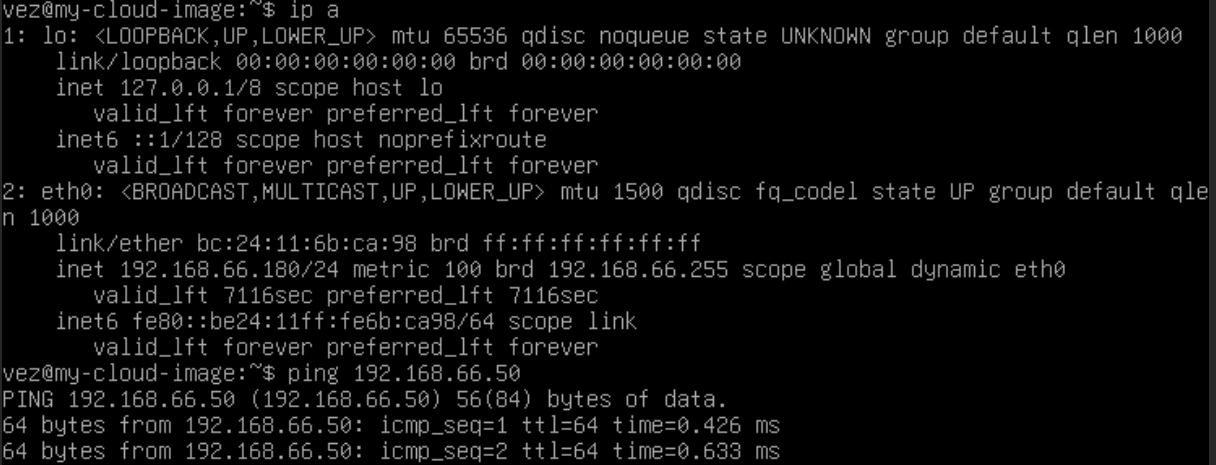
Update Cloud-Init Template and Terraform
To go further, I update the bridge used in my cloud-init template, which I detailed the creation in that post. Pretty much the same thing I’ve done with the VM, I replace the current vmbr0 with VLAN tag 66 with my new VNet vlan66.
I also update the Terrafom code to take this change into account:

I quicky check if I don’t have regression and can still deploy a VM with Terraform:
terraform apply -var 'vm_name=vm-test-vnet'
data.proxmox_virtual_environment_vms.template: Reading...
data.proxmox_virtual_environment_vms.template: Read complete after 0s [id=23b17aea-d9f7-4f28-847f-41bb013262ea]
[...]
Plan: 2 to add, 0 to change, 0 to destroy.
Changes to Outputs:
+ vm_ip = (known after apply)
Do you want to perform these actions?
Terraform will perform the actions described above.
Only 'yes' will be accepted to approve.
Enter a value: yes
proxmox_virtual_environment_file.cloud_config: Creating...
proxmox_virtual_environment_file.cloud_config: Creation complete after 1s [id=local:snippets/vm.cloud-config.yaml]
proxmox_virtual_environment_vm.vm: Creating...
proxmox_virtual_environment_vm.vm: Still creating... [10s elapsed]
[...]
proxmox_virtual_environment_vm.vm: Still creating... [3m0s elapsed]
proxmox_virtual_environment_vm.vm: Creation complete after 3m9s [id=119]
Apply complete! Resources: 2 added, 0 changed, 0 destroyed.
Outputs:
vm_ip = "192.168.66.181"
The VM is deploying without any issue, everything is OK:

Conclusion
Setting up Proxmox SDN with a VLAN zone turned out to be straightforward and very useful. Instead of tagging VLANs manually per VM, I now just pick the right VNet, and everything stays consistent across the cluster.
| Step | Before SDN | After SDN |
|---|---|---|
| Attach VM to VLAN | vmbr0 + set VLAN tag manually |
Select the right VNet directly |
| VLANs on nodes | Repeated config per node | Centralized in cluster SDN |
| IP management | Manual or DHCP only | Optional IPAM via SDN subnets |
This prepares my cluster to host my OPNsense router, and it also sets the stage for future experiments, like trying out VXLAN overlays or EVPN with BGP.
See you next time for the next step!